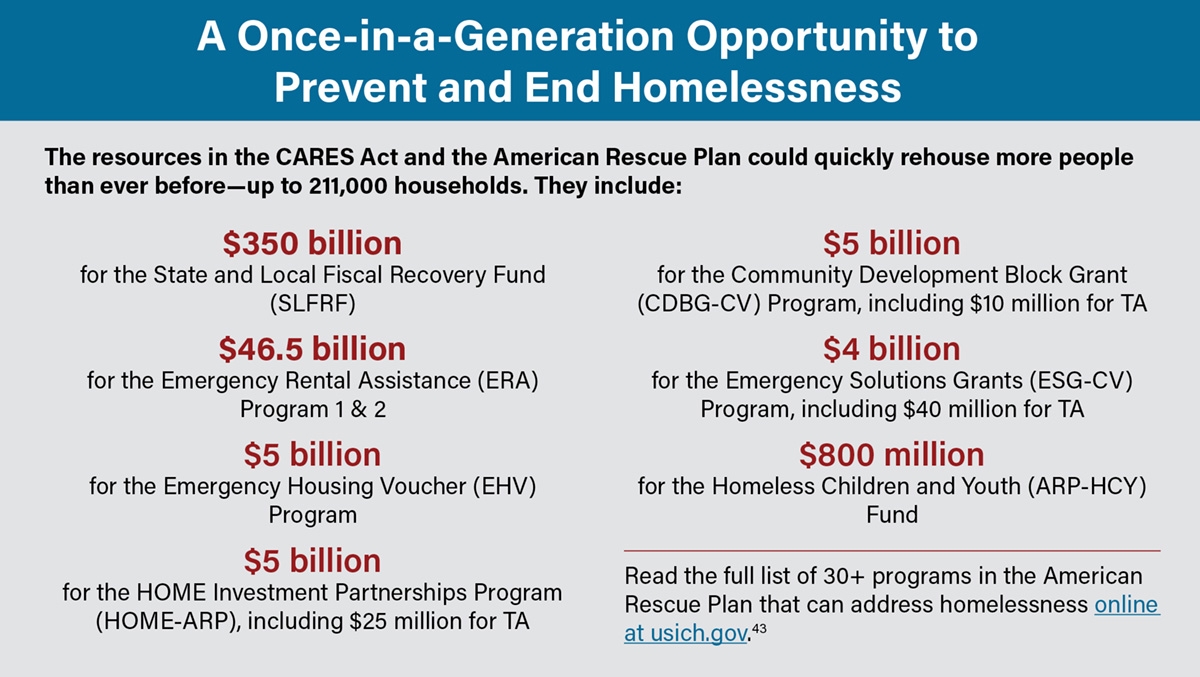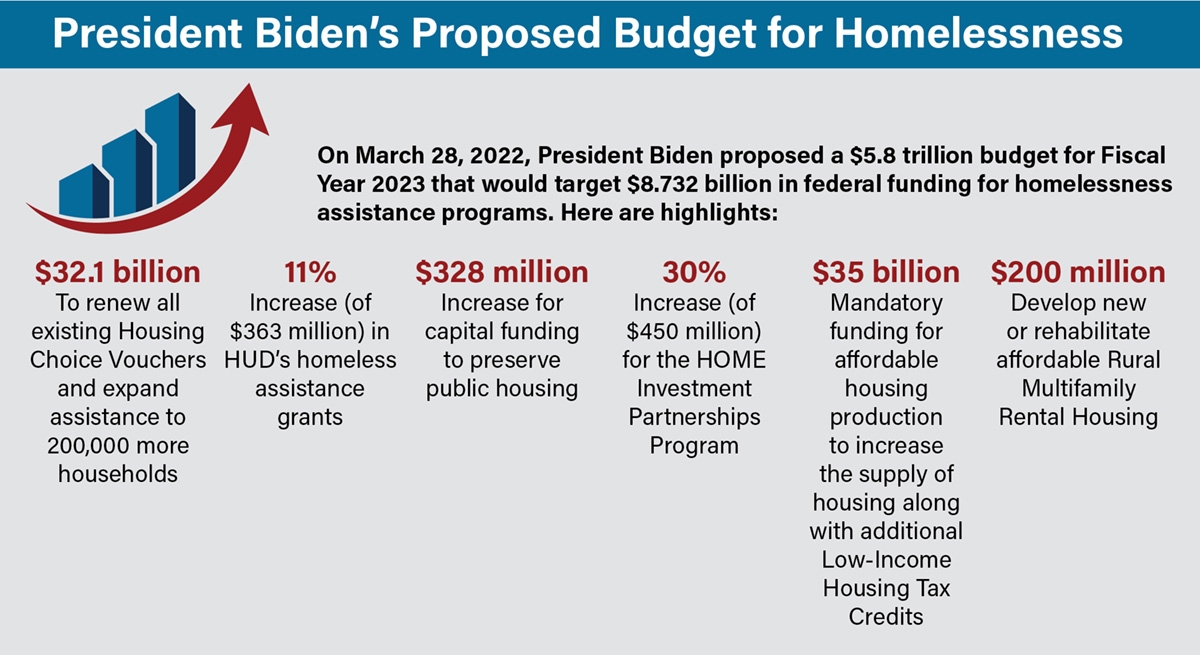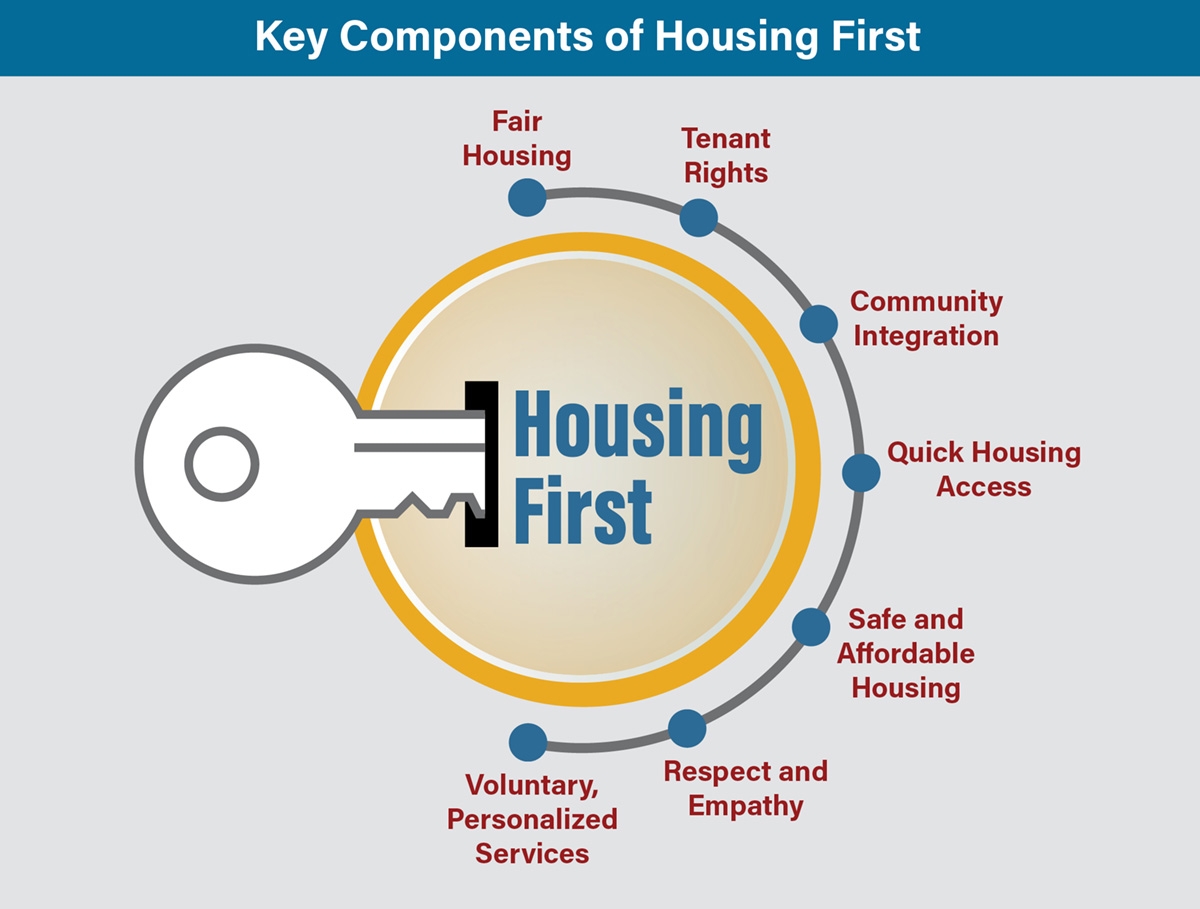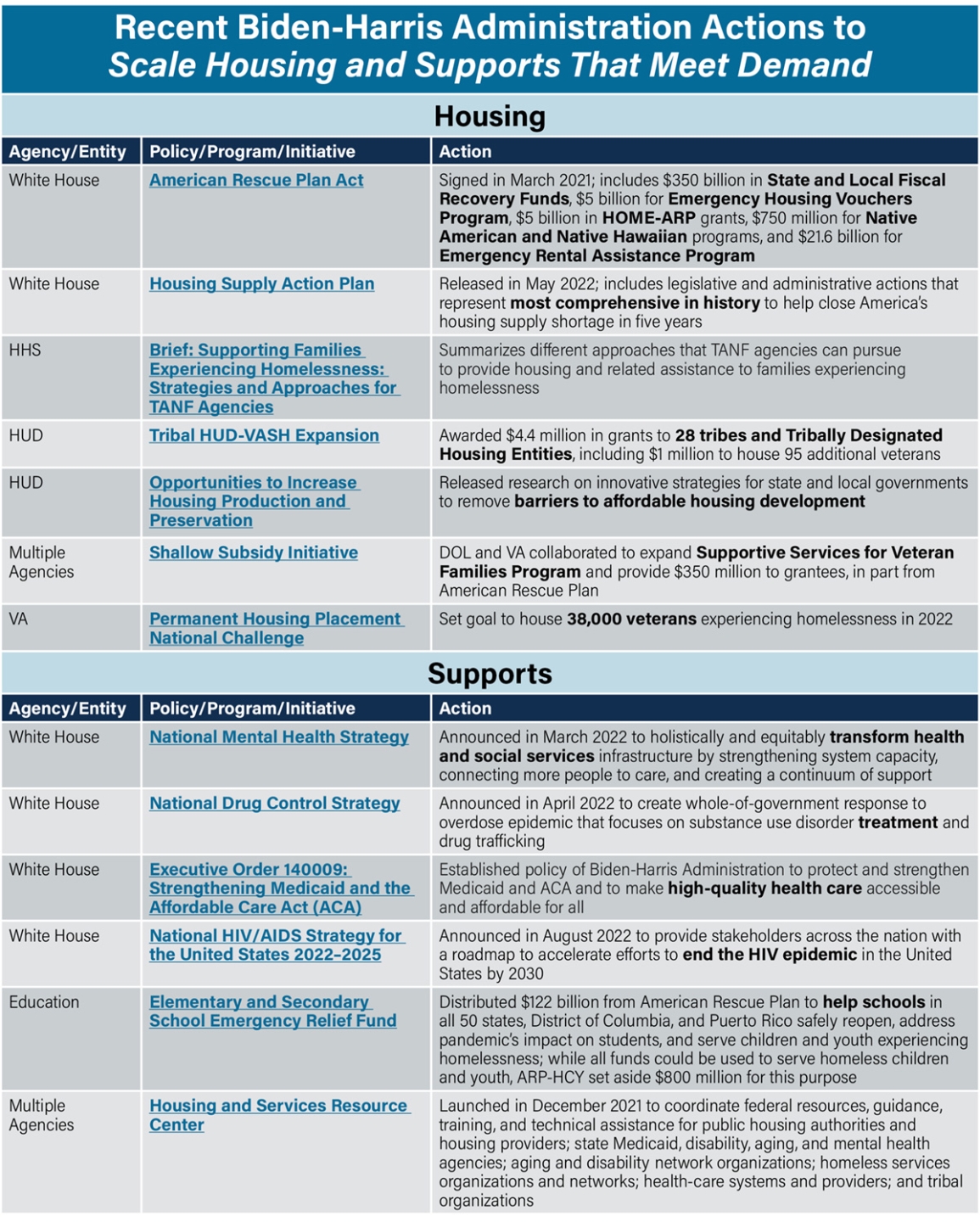Scale Housing and Supports That Meet Demand
This is an excerpt of All In: The Federal Strategic Plan to Prevent and End Homelessness. Read the full plan at usich.gov/all-in.
All In serves as a roadmap for federal action to ensure state and local communities have sufficient resources and guidance to build the effective, lasting systems required to end homelessness. While it is a federal plan, local communities can use it to collaboratively develop local and systems-level plans for preventing and ending homelessness. This plan creates an initial framework for meeting the ambitious goal of reducing overall homelessness by 25% by 2025 and sets the United States on a path to end homelessness.
This plan is built around six pillars: three foundations—equity, evidence, and collaboration—and three solutions—housing and supports, homelessness response, and prevention—all of which are required to prevent and end homelessness. Within each pillar of foundations and solutions are strategies that the federal government will pursue to facilitate increased access to housing, economic security, health, and stability. Some agency commitments, cross-government initiatives, and efforts are already underway and are highlighted throughout.
Upon release of this plan, USICH will immediately begin to develop implementation plans that will identify specific actions, milestones, and metrics for operationalizing the strategies in close partnership with its member agencies and other stakeholders representing a broad range of groups and perspectives, including people with lived experience. For more on this, please view the Framework for Implementation.
Strategies to Scale Housing and Supports That Meet Demand
The fundamental solution to homelessness is housing. When a person is housed, they have a platform to address all their needs, no matter how complex. People are most successful when that housing is paired with the right level of voluntary and accessible support based on their expressed and individualized needs and preferences. To truly bring Housing First to scale for all populations, communities need access to housing and wraparound services and other supports that can be offered to implement this approach with fidelity to the model. The strategies and actions in this section focus on increasing the supply of and equitable access to affordable housing and tailored supports for people at risk of or experiencing homelessness. They are aligned with the Biden-Harris Administration’s Housing Supply Action Plan, National Mental Health Strategy, and National Drug Control Strategy.
Strategy 1: Maximize the use of existing federal housing assistance.
While some federal housing programs are targeted to people experiencing or at risk of homelessness, most are offered more broadly to low-income people. The number of people eligible for federal housing assistance far exceeds the availability of it, and many people in need of such assistance wait years, often falling into or struggling to get out of homelessness in the meantime. To get the greatest impact from all the resources currently available to end homelessness, communities should use each resource for its best purpose while utilizing all the resources together in a coordinated and strategic fashion.
To accomplish this strategy, USICH and relevant member agencies will:
- Conduct a comprehensive review of available policy mechanisms that can increase access to federal housing programs among people experiencing or at risk of homelessness, including eligibility, admissions preferences, referral partnerships, funding incentives, and administrative fees.
- Provide guidance, tools, and technical assistance on a wide range of topics, including strategies for serving people with complex service needs; move-on strategies; accessibility strategies including the use of assistive technologies and home modifications; the use of project-based vouchers; and special housing types, such as single-room occupancy, shared housing, group homes, congregate housing, manufactured home space rentals, and cooperative housing.
- Launch a federal landlord engagement campaign to help support local efforts to increase available rental units where housing assistance can be utilized through landlord education and identifying funding for landlord incentives and risk mitigation.
- Identify and enact the full range of options to reduce documentation as a barrier to housing entry, including regulatory flexibility for federal housing programs; improving access to identification, medical, and benefits documentation needed to determine eligibility; and strengthening collaboration between federal, state, and local agencies. Eliminate federal requirements associated with having a permanent address and/or bank account to access federal assistance.
- Encourage partnerships between providers of housing, aging and disability services, and health care—including treatment for mental health conditions and/or substance use disorders—to colocate, coordinate, or integrate health, mental health, substance use disorder, safety, and wellness services with housing and create better resources for providers to connect program participants to culturally appropriate41 and gender-affirming housing resources.
Strategy 2: Expand engagement, resources, and incentives for the creation of new safe, affordable, and accessible housing.
Nationally, there are only 37 affordable and available rental homes for every 100 extremely low-income renters. In no state can a person working full-time at the federal minimum wage afford a two-bedroom apartment at the fair market rent. The actions below build off the strategies included in the Housing Supply Action Plan, which will help close the housing supply gap over the next five years. The federal government should do whatever it can to implement this plan to support and incentivize the creation of new supportive and affordable housing while encouraging states, localities and territories to review and adjust their own policies.
To accomplish this strategy, USICH and relevant member agencies will:
- Promote continued affordability of units created with Low-Income Housing Tax Credits after expiration of affordability covenants.
- Expand availability and supply of accessible and integrated housing opportunities that meet needs of older adults and people with disabilities.
- Identify and replicate strategies to increase awareness, availability, and use of assistive technology and home modifications that enable people to address accessibility issues and continue to live in their homes.
- Work with state, local, and territorial governments to expand rental assistance and low-cost capital— in part by using State and Local Fiscal Recovery Funds—for new construction and rehabilitation of housing for people experiencing or most at risk of homelessness.
- In consultation with tribal leaders and Native-serving organizations operating off tribal land, explore opportunities to strengthen the Native American Housing Assistance and Self Determination Act programs for tribes and tribally designated housing entities.
- In consultation with Native Hawaiian leaders, explore opportunities to strengthen the Native Hawaiian Housing Block Grant Program.
- Encourage use of programs like HOME, HOME-ARP, and National Housing Trust Fund allocations to support housing development for very low-income units that target people experiencing homelessness.
- Encourage states to create preferences in their LIHTC Qualified Allocation Plans (QAPs) to increase investments in housing targeted to people experiencing homelessness and educate local stakeholders on their ability to influence the priorities in their states’ QAP through the provision of incentives.
- Encourage states and cities to review and update their zoning laws and policies to include more land for multiple units (like multifamily housing), offer density bonuses to developers, ease height and density restrictions, create land banks and streamline the permitting and approval process for missing-middle housing types, such as Accessory Dwelling Units.
- Engage Public Housing Agencies as they pursue strategies to revitalize and create public housing units to consider their community obligation to help prevent and address homelessness.
- Explore opportunities to strengthen project-based subsidy programs such as Project Based Rental Assistance (PBRA) and project-based vouchers to increase the creation of deeply affordable housing.
- Improve the Title V Federal Surplus Property Program to increase the number of Title V properties that are converted for use by the homeless services system.
- Engage the financial and business sector, private sector, health care system, philanthropic organizations, and faith-based groups that may be willing to donate resources, land, or property for the purpose of building affordable housing.
- Engage congressional committees on the need to expand federal funding for the development of new affordable housing.
Strategy 3: Increase the supply and impact of permanent supportive housing for individuals and families with complex service needs—including unaccompanied, pregnant, and parenting youth and young adults.
Unlike other assistance, permanent supportive housing has no time restrictions for people with disabilities who are experiencing homelessness. Using a Housing First approach, housing is offered without preconditions and with a broad array of voluntary, trauma-informed wraparound services. When implemented to fidelity, the model is a proven solution that leads to housing stability as well as improvements in health and well-being. Although the supply of permanent supportive housing has increased over the years, there is still a shortage of it across the country relative to the need.
To accomplish this strategy, USICH and relevant member agencies will:
- Conduct a gaps analysis of permanent supportive housing needs nationally that includes an examination of racial equity.
- Provide guidance, tools, and technical assistance on effective strategies to braid federal, state and local funds for the purpose of expanding permanent supportive housing.
- Examine opportunities to streamline the process of braiding federal funding sources within permanent supportive housing.
- Highlight and promote examples of how state Medicaid, aging, disability, and health care agencies have coordinated housing assistance with Medicaid-financed health care and supportive services for people with high acuity of health needs and encourage expansion of Medicaid in states that have not yet done so.
- Examine requirements (including eligibility and recordkeeping) associated with federally funded permanent supportive housing to create greater flexibility to serve people with intense service needs, including people experiencing chronic homelessness, and ability to tailor programming to meet needs of specific key populations.
- Promote and amplify lessons learned from the joint HUD/HHS Housing and Services Resource Center.
- Where federal funds are used to create permanent supportive housing, encourage the creation of non-discriminatory preferences for property owners that will agree to operating the property using a Housing First approach and will not further restrict or limit eligibility.
Strategy 4: Improve effectiveness of rapid rehousing for individuals and families—including unaccompanied, pregnant, and parenting youth and young adults.
Rapid rehousing is an intervention designed to help people quickly exit homelessness and return to permanent housing. Rapid rehousing assistance is offered without often-discriminatory requirements for employment, income, sobriety, or clean criminal records; and the resources and services provided are typically tailored to the unique needs of the person. While the supply of rapid rehousing has grown significantly, continued efforts are needed to strengthen effective implementation of the core components—housing identification, rent and move-in assistance, and case management.
To accomplish this strategy, USICH and relevant member agencies will:
- Provide guidance, tools, and technical assistance to communities to assess outcomes being achieved and tailor their financial subsidy and services practices in order to improve outcomes and to reduce returns to homelessness among individuals and families, including households residing in high-cost, low-vacancy markets.
- Promote and amplify lessons learned from VA’s Supportive Services for Veteran Families program, HUD-funded programs (including YHDP), and program evaluations and research studies on effective models.
- Promote effective landlord engagement strategies.
Strategy 5: Support enforcement of fair housing and combat other forms of housing discrimination that perpetuate disparities in homelessness.
Despite passage and implementation of the federal Fair Housing Act in 1968, many people still face systemic housing discrimination. The federal government can and should vigorously enforce the Fair Housing Act and other federal fair housing and civil rights laws that provide housing protections, including, but not limited to: Title VI of the Civil Rights Act of 1964, Section 504 of the Rehabilitation Act of 1973, the Americans with Disabilities Act, and the Age Discrimination Act, as applicable. In addition to protecting the federally protected classes under the Fair Housing Act, other federal fair housing and civil rights laws, and the Violence Against Women Act (VAWA), agencies should explore ways to protect people using vouchers and other housing subsidies as well as other groups that frequently encounter housing discrimination—especially people with criminal records.
To accomplish this strategy, USICH and relevant member agencies will:
- Encourage states and localities to adopt and strongly enforce source-of-income anti-discrimination laws.
- Foster greater collaboration between homeless programs and fair housing programs at the federal, state, and local levels, including with landlords and property owners.
- Provide data, tools, and guidance in line with the Affirmatively Furthering Fair Housing mandate so that communities are able to track key outcomes, including how to evaluate where affordable housing is being built and who is accessing available housing.
- Provide outreach and education on HUD’s 2016 Guidance on Application of Fair Housing Act Standards to the Use of Criminal Records by Providers of Housing and Real Estate-Related Transactions.
- Provide updated HUD guidance and technical assistance on the intersection between the Fair Housing Act and Violence Against Women Act.
- Strengthen compliance with and enforcement of housing protections under the Violence Against Women Act (VAWA) and related federal, state, and local laws.
- Provide guidance, training, and technical assistance to state and local governments, and territories on the linkages between housing discrimination and homelessness.
- Examine fair housing regulations and policies to identify potential legal barriers to advancing equity for all groups protected by the Fair Housing Act and include ways to allow communities to adopt and implement a targeted universalism framework while ensuring compliance with fair housing.
Strategy 6: Strengthen system capacity to address the needs of people with chronic health conditions, including mental health conditions and/or substance use disorders.
People experiencing homelessness have higher rates of HIV infection and are at higher risk for chronic health conditions like asthma, diabetes, lung disease, and serious heart conditions. People with HIV who are experiencing homelessness or lack stable housing are also more likely to delay HIV care and less likely to access care consistently or to adhere to their HIV treatment. Approximately 25% of people experiencing sheltered homelessness have a mental health condition, and roughly 35% have a substance use disorder. These rates tend to be higher for people living unsheltered and for people with disabilities. To end homelessness, we must transform our health and supportive services infrastructure to address the needs of people experiencing homelessness with a mental health condition and/or with a substance use disorder holistically and equitably. The American Rescue Plan laid the groundwork by providing critical investments to expand access to primary health care as well as treatment for mental health conditions and/ or substance use disorders.
To accomplish this strategy, USICH and relevant member agencies will:
- Invest in accessible programs grounded in evidence and expand the pipeline of providers to address mental health conditions and/or substance use disorders and improve their geographic distribution to target areas with the greatest unmet need.
- Pilot new approaches to train a diverse group of paraprofessionals to increase the number of community health workers, peer support, and other health support workers providing accessible health care and other services, including treatment for mental health conditions and/or substance use disorders , in underserved communities.
- Invest in models that include peer support specialists.
- Integrate treatment for mental health conditions and/or substance use disorders into primary health-care settings and other non-traditional settings that lower barriers to services.
- Promote harm reduction and low-barrier models to provide primary healthcare services and treatment for mental health conditions and/or substance use disorders.
Strategy 7: Maximize current resources that can provide voluntary and trauma-informed supportive services and income supports to people experiencing or at risk of homelessness.
Ending homelessness is dependent not only on an adequate supply of housing but also on the availability of community-based, high-quality, low-barrier, and voluntary supportive services that are delivered using a trauma-informed approach. Unfortunately, funds that can pay for supportive services are limited and often have complex requirements that can create a barrier to access for people who are truly in need of those services. While new resources for supportive services are identified, there are existing levers that can be used to maximize the current resources.
To accomplish this strategy, USICH and relevant member agencies will:
- Examine policy and program rules to identify ways to encourage earned income, increased savings, and wealth-building in order to address the “benefits cliff.”
- Identify ways to align eligibility criteria across programs (i.e., categorical eligibility) so that people do not have to apply and qualify for each program separately (e.g., children in households that receive SNAP are considered categorically eligible for free school meals). Similar categorical eligibility could be applied for other programs.
- Invest in peer-led housing and service delivery models, like recovery coaches for substance use disorders, peer specialists in mental health conditions, and youth mentors/staff with lived experience in youth programs.
- Review federal program requirements and policies associated with programs that serve people at risk of or who are experiencing homelessness to ensure greater compatibility with a Housing First approach with a priority on flexibility, accessibility, and personal choice.
- Provide guidance, training, and technical assistance on accessible and inclusive models and approaches, including but not limited to: person-centered, trauma-informed care, Critical Time Intervention, gender-affirming care, and harm reduction strategies for substance use and health care.
- Identify opportunities to expand upon the federal funding sources that can pay for an array of supportive services as well as training to ensure they are offered with fidelity to best-practice approaches.
- Explore opportunities for philanthropic partners to provide funding for flexible and accessible supportive services.
Strategy 8: Increase the use of practices grounded in evidence in service delivery across all program types.
Although there is always a need for continued learning and evaluation, there is substantial evidence and research supporting several service delivery models, such as Critical Time Intervention (CTI) and Assertive Community Treatment (ACT) teams.
To accomplish this strategy, USICH and relevant member agencies will:
- Promote service delivery models—such as Critical Time Intervention (CTI), Assertive Community Treatment (ACT) Teams, and harm-reduction—that are person-centered, culturally appropriate, disability competent, support individual choice, and encourage voluntary participation.
- Encourage states to consider Medicaid-financed service approaches and models.
- Provide tools, guidance, and technical assistance on cultural responsiveness and humility as well as disability competence in the context of service delivery.
- Given the effectiveness of the SSI/SSDI Outreach, Access, and Recovery (SOAR) model, assess feasibility of replicating this model for other federal programs and agencies to connect to other entitlements and benefits.
- Building on the Executive Order on Transforming Federal Customer Experience and Service Delivery to Rebuild Trust in Government, identify opportunities to improve the experience of people experiencing, at risk of, or exiting homelessness in their interactions with key federal agencies, including SSA, USDA, DOL, HHS, VA, ED, and Treasury.
- Provide tools to help communities evaluate the consumer experience in their own programs and systems and implement improvements based upon the feedback received.






